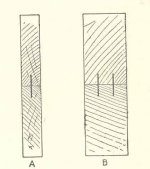David, My apologies for renaming you? Thank you for your reply; my reply was based on period method, only?
So solid timber rules. (Solid pine substrate).
To add more strength, today though? Without bending any period rule?
I would first veneer cross grain, on both sides?
Then with my final veneer, mimic solid timber, by veneering length ways.
This would give the stability and strength of plywood, but on solid timber. Keeping correct to our ancestors ways, which started Period furniture.
constructing this way would add strengh to the turret corners also.
one other note, The correct matching of the timber rays is so important, to keep the board flat and straight, I attach a diagram to illustrate this method, the boards could be just a rub joint? or dowel? or lose fillet.
Jo Hemingway
sharing the tricks of the trade
1968-2009

